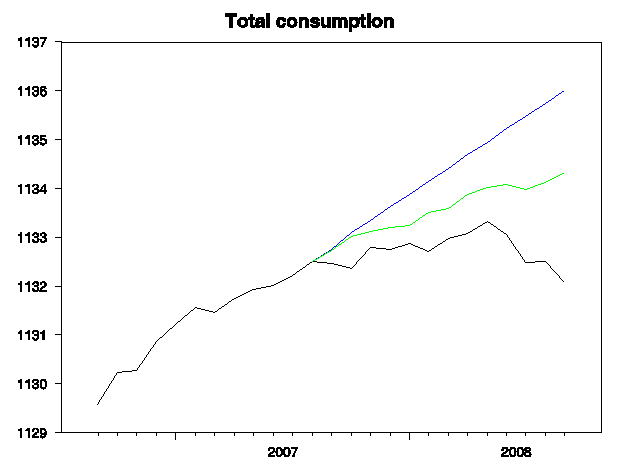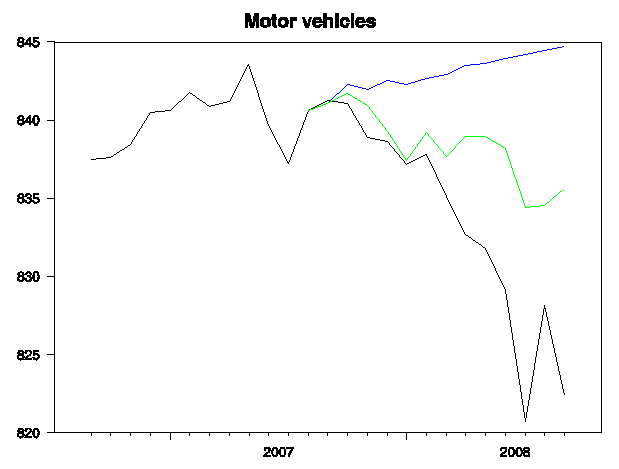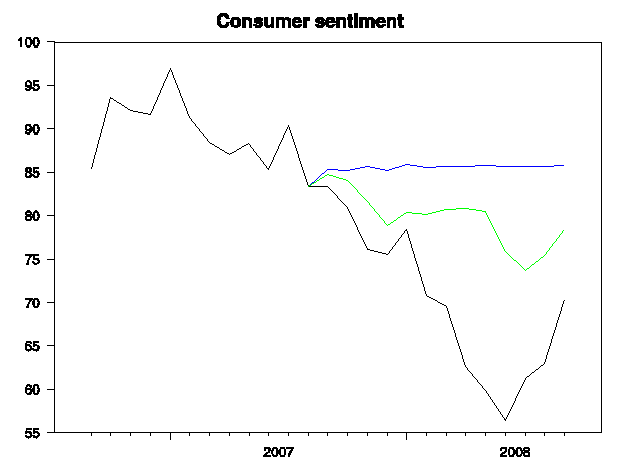This is the first in what I’m planning will be a series of posts discussing the contribution that the energy price spike of 2008 made to our present economic difficulties. In this first installment, I revisit a very interesting research paper on the response of consumer spending to energy price increases written by Lutz Kilian (Professor of Economics at the University of Michigan), and Paul Edelstein (Senior Economist for Decision Economics). I first brought this paper to the attention of Econbrowser readers in the spring of 2007. I thought now would be a good time to take a look at how well the equations in Edelstein and Kilian’s paper can describe what we saw happen in the later part of 2007 and first half of 2008.
Edelstein and Kilian summarized the historical correlations between energy prices and economic activity in terms of some basic forecasting equations. They started with a simple model that could be used to predict real personal consumption expenditures on the basis of past consumption spending and past changes in the relative price of energy. Their measure of energy prices was scaled by the share of energy purchases in total spending, so that if their energy-price measure goes up by one unit, it means that a consumer who tried to consume the same amount of energy as before would have to cut total real spending on other goods and services by 1%. In the graph below, I have reproduced their calculation for how their forecast of real consumption expenditures in month t+s would change if an energy price increase reduced disposable income by 1% in month t. This calculation is plotted as a function of s, how many months into the future we’re trying to forecast, so that as you move to the right along the graph, you’re looking at the consequences farther and farther into the future of an event (an energy price increase) that occurs now.
 |
The graph shows, not surprisingly, that when energy prices go up, consumer spending falls. But there are two surprising things about the quantitative character of this response. The first surprise is the delay– energy prices go up at time t, but the biggest consequences for consumption spending aren’t seen until s = 12 months later. The second surprising feature of these results is the magnitude. If consumers continued to purchase the same number of gallons of gasoline as they had before, a shock of the size analyzed in this graph would require them to reduce spending on other items by 1%. Yet eventually they historically would be predicted to reduce spending by 2.2%. Why do consumers cut spending by so much more than the shock itself?
Edelstein and Kilian proposed to find some answers to these questions by looking at specific components of consumption spending. The three graphs shown below break spending down into services, nondurables, and durables. The magnitude of the response of the first two categories– about a 1.5% reduction in spending on services or nondurables– is more in line with what we might have expected. The real action is in durables. Purchases of items such as appliances and automobiles respond very dramatically to a change in energy prices.
 |
Looking further at the composition of durable goods, Edelstein and Kilian found that by far the most dramatic response is in terms of spending on motor vehicles and parts. Unlike the other categories of spending, this response is huge and immediate.
 |
Once we state the basic facts this way, the results seem a lot less mysterious. The response of spending on autos to an energy price increase is not simply a matter of consumers having less disposable income, but instead involves a lot of other factors, such as consumers switching to smaller cars or postponing purchases until they have more confidence about where gasoline prices are going to settle down. As a result of decreased spending, the income of those employed in the auto sector would decline, and for these individuals, their loss in purchasing power is much greater than their personal increase in fuel expenses. As people who derive their income from manufacture and sale of automobiles and parts reduce their spending, the aggregate consequences can accumulate over time, accounting for both the magnitudes and the delays in the response of other categories of consumption spending.
Another interesting finding by Edelstein and Kilian was that consumer sentiment is quite sensitive to energy prices, with a 1% loss in purchasing power quickly translating into a 15% drop in the Reuters/Michigan index of consumer sentiment.
 |
The economics literature is filled with statistical models that seem to do a very good job at fitting the data in hand, but then fall apart when applied to data that arrive after the paper is published. I was curious to see how well the Edelstein-Kilian forecasting equations would have performed over the period since their paper was written. The heart of the system used to generate the graphs above is an equation that predicts a category of consumption spending one month ahead on the basis of the current and past consumption spending and energy prices. I took the parameters as estimated from the historical data set used by Edelstein and Kilian (1970:M1 to 2006:M7), and formed forecasts of each new observation between 2006:M8 and 2008:M9, one month at a time. I then calculated the average squared error of those forecasts. These mean squared forecast errors are reported in the first column of the table below. These are compared in the second column with the errors from a model that forecasts the spending component from its own lagged values alone. For each of the equations used in the graphs above, the Edelstein-Kilian specifications exhibit significant post-sample success.
| Variable | With energy prices | Autore- gression | Percent improvement |
|---|---|---|---|
| PCE | 0.081 | 0.121 | 33% |
| services | 0.023 | 0.026 | 8% |
| nondurables | 0.283 | 0.366 | 23% |
| durables | 1.64 | 2.36 | 30% |
| autos | 8.65 | 11.76 | 26% |
| sentiment | 17.5 | 19.2 | 9% |
One can also use these equations to estimate how much of a contribution energy prices made to recent developments. I used the Edelstein-Kilian regressions to form a forecast for the path of real consumption expenditures looking forward from September 2007. That forecast is indicated by the blue line in the graph below, and basically called for consumption spending to continue along the same sort of path we saw earlier in 2007 and 2006. The actual path for spending, indicated by the black line, grew much more sluggishly than this after September 2007 and began to decline in June 2008.
 |
By the nature of this system, one can by definition decompose the gap between the black and blue lines into a series of individual forecast errors, namely the sequence of errors we made trying to predict energy prices one month ahead, and the month-by-month errors we made predicting consumption given those energy prices. One can then use such calculations to ask the following question: What if there had been no surprises with energy prices, and the only errors had been those associated with trying to predict consumption spending conditional on knowing energy prices? [This is an easy calculation to perform using the RATS “history” command]. The result of that “what-if” calculation is plotted as the green line above. The difference between the green line and the blue line could be interpreted as the fraction of the slowdown in consumption spending that one might attribute to energy prices alone. The graph suggests that energy prices played a very significant role in the slowdown in consumption spending.
I performed a similar calculation for spending on motor vehicle and parts, and found that the oil shock made a major contribution to the problems for this sector for 2007:Q4 through 2008:Q2.
 |
Energy prices were surely also a significant factor in the dramatic deterioration of consumer sentiment in the early part of this year.
 |
My conclusion is that the oil price shock made an important contribution to consumption spending in general and purchases of motor vehicles and parts in particular in the later part of 2007 and first half of 2008. In my next post, I intend to discuss the implications of this for the economy as a whole.
Technorati Tags: oil,
oil prices,
oil shocks
For anyone who’s interested Marx has a very interesting discussion on the effect of changes in raw materials prices on the rate of profit here
http://www.marxists.org/archive/marx/works/1894-c3/ch06.htm
“Other conditions being equal, the rate of profit, therefore, falls and rises inversely to the price of raw material.”
When you consider that most of the bubble-era housing construction was out on the fringiest fringes of sprawled-out nothingness, it makes sense that a shock in oil prices would make this sort of lifestyle unsustainable. If you have to drive miles just to get to work or to go shopping, a shock in gas prices is going to devastate your finances, making it harder to pay a mortgage and making moving out to these areas less appealing.
Of the money we have seen thrown around thus far let me ask you this, that 168 billion that our country borrowed to give away to us in the form of an “economic stimulus package” …did it do a darn thing to create jobs or stimulate our economy? NO, nothing. And we borrowed the money from China.
This past year the high cost of gas nearly destroyed our economy and society. More people lost jobs and homes as a direct result of that than any other factor in our history.
Fannie and Freddie continue to get all the blame. Of all the homes I have seen lost in my area SW FL and believe me I have seen many, none were due to an adjustable mortgage. They were due to lack of work.
Families went broke at the pump alone. Then added to that most saw record rate hikes at their utility companies. The high cost of fuel resulted in higher production and shipping costs that were passed on to the consumer, in most cases higher prices for smaller packaging.
Consumers tightened their belts, cut back, went out to eat less or stopped totally. Drove around on tires that needed replacing longer, some even quit buying medicines they really need.Unfortunately cutting back and spending less results in even more layoffs. A real economical catch-22.
And, as we are doing the happy dance around the lower prices at the pumps OPEC is planning to cut production to raise prices. They are even getting Russia in on the cutbacks. Oil is finite. We have used up the easy to get to reserves already. It will run out one day.
We have so much available to us. Solar and Wind are free sources of energy. Of course to get the harnessing process set up is somewhat costly it is still free energy.
It would cost the equivalent of 60 cents per gallon to charge and drive an electric car. The electricity to charge the car could be generated by solar or wind at least in part and in most cases totally.
If all gasoline cars, trucks, and suvs instead had plug-in electric drive trains, the amount of electricity needed to replace gasoline is about equal to the estimated wind energy potential of the state of North Dakota. What a powerful resources we have neglected.
Jeff Wilson has a profound new book out called The Manhattan Project of 2009 Energy Independence Now. http://www.themanhattanprojectof2009.com Powerful, powerful book! Also, if you think electric cars are way out there in some futuristic lala land please check out the web site for a company Better Place. http://www.betterplace.com/ they are setting up infrastructures in San Francisco, San Jose and Oakland as well as the state of Hawaii to accommodate electric car use.
I think we need to rethink all these bailouts and stimulus packages. We need to use some of these billions to bail America out of it’s dependence on foreign oil. Create clean cheap energy, create millions of badly needed new green collar jobs and get out from under the grip foreign oil has on us. What a win -win situation that would be for America at large
If you look at it from a consumer’s point of view you see that one of the easiest, least harmful way to adjust to higher prices cutting you standard of living is to delay buying a new car. Typically, when you finish your payments you enjoy a short period of not making car payments. But after an oil price shock it is very easy to stretch out that period when you do not have to make car payments and use that to absorb the impact of higher oil prices.
Two things make this harder to do now than in the 1970s. One is the growth in leasing. If you lease you can not do nothing when your lease expires. You have to get a new lease either on the existing auto or on another one. Second is the lengthening of the average car loans. In 1975 the average car loan was for 37.6 months, just over 3 years. In 2006 it was 62.3 months of just over 5 years.
So if your regression that shows a big impact of oil on auto purchases is highly dependent on the
1970s experience it may overstate the impact in the short run and understate it in the long run because of the change in the terms of auto loans
and the growth of auto leases.
So why aren’t low oil prices rocketing the global economy towards recovery? It has been low for a couple of months now.
Another way to look at the change in auto loans is that in the 1970s ever year about one-third of consumer could opt to delay buying a new car and get out of making monthly car payments.
Now in any year under 20% of consumers can delay buying a new car to get out from making monthly car payments.
Maybe that explains why auto sales held up better in 2006 and 2007 and then collapsed in 2008.
GK — the impact of oil prices has a small short run impact and a large long run impact, partially because of the auto loan issue I just explained.
So we are now still seeing the large negative long run impact of the prior years run up that is swamping the small short run positive impact of the current drop in oil prices.
I don’t know why, but if what I think I gleaned from the papers is right, downward spikes don’t have nearly as much impact as upward spikes because of the uncertainty upward spikes cause. It takes about a year for consumption effects to show.
And this time is special too. People didn’t just reduce consumption, people picked up bad habits due to poor reaction to obscenely high oil prices. Those habits aren’t likely to go away for everyone just because oil prices go down. People driving too slowly prevent everyone from moving at more efficient speeds and create congestion at bottlenecks. You can only move as fast as the car infront of you, unless of course you can safely go around.
Even if we were to increase our consumption (of gas) to previous levels, we won’t get the level of activity we did then because fuel efficiency has gone down. Of course it’s hard to say how much it has gone down the past three years, or know if it’s significant. Eyeballing it, it looks like about 1%.
JDH, thanks for a clear summary on a timely topic. The sharp drop in durables consumption is expected, as these purchases can be delayed. The surprise to me is that services and non-durables drop for 15+ months – and counting – the charts don’t show an eventual leveling off – and drop more in percent terms than the oil increase. I wonder if this consumer spending behavior is linked to consumer savings behavior. The hypothesis to test would be that savings objectives are missed when unexpected high oil spending occurs and consumers then cut spending on non-durables and services for an extended time to try to replenish savings. Maybe that’s too reasonable and old fashioned.
spencer,
But the impact on consumer spending of oil prices is immediate.
Also, your long-run/short-run theory is tipping more in favor of low oil prices by the day.
Like GK above, I have to question why the now-low price of oil–half again as low as a year ago–has not had a stimulative effect on consumption.
The reality is that there are so many other factors at play this time, starting with wealth destruction due to the housing debacle. That hasn’t happened before (at least on such a scale for so long a time) so it becomes one of the moving parts not accounted for in the model. Some other factors: massive credit crisis–even for well-qualified borrowers (both in housing and autos to link to the above), and increasing unemployment and fear of job loss.
Those would be enough for anyone not to spend more now than a year ago–especially on most people’s second-largest purchase, an auto.
The housing collapse force the price of oil lower than it otherwise may have been. This will hasten the collapse of despotic regimes in Iran, Venezuela, and elsewhere.
So Americans are still fighting despotism and evil, simply through crushing the WW demand for oil. So something good is still coming of this.
Terry:
Debt overhang and fear…those dollars not spent on fuel are being used to pay down debt and save for the impending layoff…
So even if banks want to lend…who wants to borrow? There is so much uncertainty it is hard to plan for next months grocery bill, let alone major purchases…
And this coming from someone who drives 10 miles a week in a very old car….
Another question is how many cars do Americans need? How many families do you know that own 2 cars? Three cars? These are Durable goods…and their lifespan can be extended substantially….
The paradox of savings? Maybe?
Anirvan Banerji has in the past mentioned the Katona effect.
http://www.thestreet.com/comment/spincycle/1076978.html
—-
I’ll tell you why. The fact is, throughout the last 50 years, there has never been a spike in oil-price inflation of this magnitude without a subsequent recession. That’s right — never. And a spike in oil-price inflation preceded almost every recession.
Why is that? To understand the link, it’s useful to examine the so-called Katona effect, named after the late George Katona of the University of Michigan. Katona was an economist and psychologist who formulated a view that the timing of consumer spending is linked to price-level volatility. This view was based on what he had learned from his consumer surveys: When consumers encountered an unexpected jump in prices, consumption fell and savings increased.
——-
To all the good reasons above I’ll add another: the consumer doesn’t believe it. Loss of faith in all of our institutions has created a very skeptical public. Most people see an obvious correlation to the elections and expect the price of gas to go right back up.
I think it can be summed up that when there is an price shock, there’s less certainty. A downward shock does not decrease uncertainty.
Yes, debt overhang and fear are the main factors.
If this were a normal recession, all the elements of recovery are in place :
1) Low fuel prices
2) Very low interest rates
3) Productivity growth is high, and technological innovation continues apace.
4) The duration of the recession has already been above average.
But this is not a normal recession….
sure blame evil foreign oil .
what about big oil?the profits big oil
have posted over the last year?
5 will get you ten no oil co posts a loss this
quarter.
the switch to renewables is inevitable
but expect a pushback from big oil
will they be part of the change or be obstructionist?
But surely the November stats demonstrate that the fall in raw materials prices is already having an effect reflating consumer demand?
November PCE rose by 0.6% once the impact of deflation was included, the largest jump in two years.
What will be interesting to see is the December stats, chain store sales rose albeit from historic lows, could this signify that consumption is indeed recovering already?
The analysis done by Marx is indeed very interesting. The States reaction to the eighteen sixties’s crisis was the Public Works Act of 1863, providing jobs to “operatives”. It sounds similar to President Obama’s investment program in public infrastructure. Was anything new in economy invented in these last 150 years? Is Marx’s analysis still valid in 2009 as in 1870?
The oil shock also triggered the collapse of the the housing bubble as is well documented by Joseph Cortright at
http://www.muninetguide.com/articles/Gas-Prices-Impact-Suburban-Housi-272.php The post by “Bill” above is well substantiated by Cortright.
Craig, the Cortright paper is very ineresting and a pretty good piece of work.
However, I’m skeptical of many of its conclusions. This is due to two shortcomings: 1.) It doesnt look at time. Because it only looks at transportation spending relative to income and travel distances, we arent seeing real consumption difference. People may spend less income, but still waste more time on travel. Even with $4 gas, time is more valuable than gas, especially in the high income, population dense areas celebrated in the paper. 2.) It doesnt look at actual resource consumption. Transportation may be a smaller percentage of income, but absolute amounts may be higher. Vehicle miles travelled may be smaller, but miles per gallon may be much lower resulting in more fuel consumed per person.
Incomes may be lower in less dense places because people value their time more than they are paid for it.
And dont forget elevators. They may not use a significant amount of power, but they consume a bit of time.
BR,
the thing is that differently from the early ’00 experience, now consumers have been facing a net loss of real estate wealth; furthermore, the mess is global: recall what Banerji wrote in September 2000:
It’s really ironic, history is repeating herself
The model shows how sensitive the consumer spending response is to energy price hikes. Clearly we have an overwhelming dependence on a soon to be exhausted resource – oil.
Even if we manage to kick start the world economy again – are we not facing this same situation all over again as soon as demand causes the same price pressures on the finite resource – oil – thereby slowing consumer spending once more?
Ultimately of course we will not be able to have an economy based on the trade of goods which depend on oil at every stage of the production cycle, because the price will be too high.
What then will our economies be based on?
Ideas anyone…….??!!